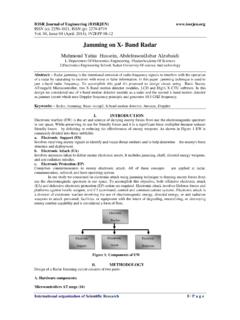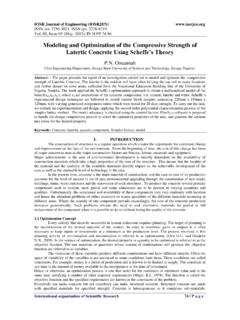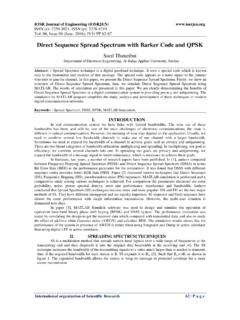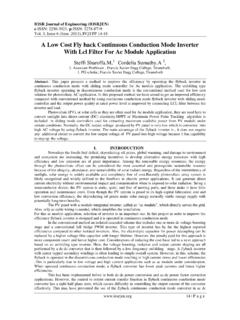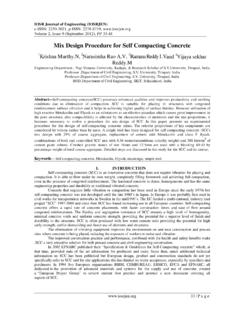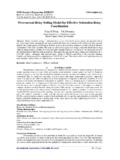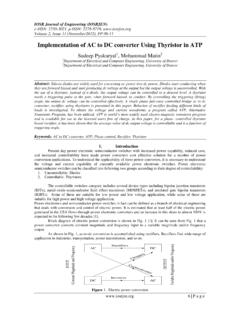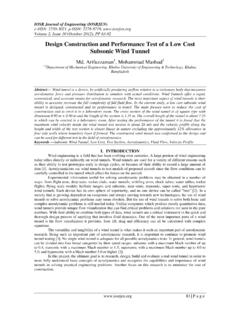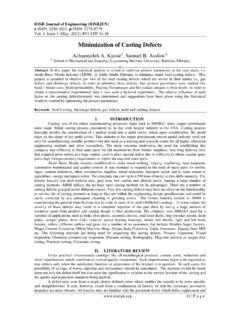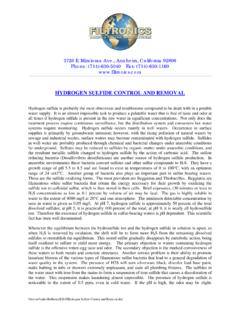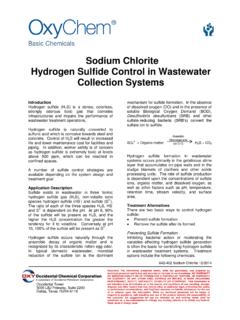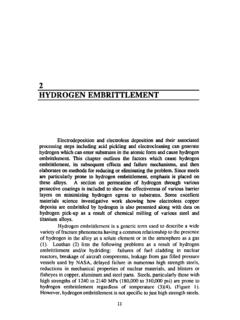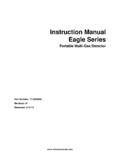Transcription of Removal of Sulfur in Petroleum Refining Using DCS
1 IOSR Journal of Engineering (IOSRJEN) ISSN (e): 2250-3021, ISSN (p): 2278-8719 Vol. 04, Issue 05 (May. 2014), ||V5|| PP 19-22 International organization of Scientific Research 19 | P a g e Removal of Sulfur in Petroleum Refining Using DCS 1 Assistant Professor & Head, Dept. of EIE, 2 Assistant Professor, Dept. of EEE, Thiruvalluvar College of Engineering and Technology,Vandavasi. Abstract: - Petroleum Refining area Sulfur is naturally present as an impurity in fossil fuels. When the fuels are burned, the Sulfur is Released as Sulfur dioxide an air pollutant responsible for respiratory problems and acid rain. Environmental regulations have increasingly restricted Sulfur dioxide emissions, forcing fuel Processors to remove the Sulfur from both fuels and exhaust gases.
2 The cost of removing Sulfur from natural gas and Petroleum is high. In natural gas, Sulfur is present mainly as hydrogen sulfide gas (H2S), while in crude oil it is present in Sulfur -containing organic compounds which are converted into hydrocarbons and H2S during the Removal process (hydro desulfurization). This well-established process uses partial combustion and catalytic oxidation to convert about 97% of the H2S to elemental Sulfur . Implement Distributed Control System (DCS) CENTUM CS3000 to automate the Removal process in Petroleum Refining . Keywords: - DCS, Valve, Parameters, Automation I. INTRODUCTION Hydrodesulfurization(HDS) is a catalytic chemical process widely used to remove Sulfur (S) from natural gas and from refined Petroleum products such as gasoline or petrol, jet fuel, kerosene, diesel, and fuel oils.
3 The purpose of removing the Sulfur is to reduce the Sulfur dioxide (SO2) emissions that result from Using those fuels in automotive vehicles, aircraft, locomotives, ships, gas or oil burning power plants, residential and industrial furnaces, and other forms of fuel combustion. Another important reason for removing Sulfur from the naphtha streams within a Petroleum refinery is that Sulfur , even in extremely low concentrations, poisons the noble metal catalysts (platinum and rhenium) in the catalytic reforming units that are subsequently used to upgrade the octane rating of the naphtha streams[3]. The industrial hydrodesulfurization processes include facilities for the capture and Removal of the resulting hydrogen sulfide (H2S) gas.
4 In Petroleum refineries, the hydrogen sulfide gas is then subsequently converted into by product elemental Sulfur or sulfuric acid (H2SO4). II. OBJECTIVE The main objective of the project is to Design and Develop a Removal of Sulfur in Petroleum Refining Using DCS Integration. Programming the system in DCS Using function block diagram. To remove the Sulfur in natural gas, diesel, petrol, for emission control process. The industrial hydrodesulfurization processes include facilities forthe capture and Removal of the resulting hydrogen sulfide (H2S) gas. Finally the hydrogen sulfide gas is then subsequently converted into by product elemental Sulfur or sulfuric acid (H2SO4).Yokogawa has developed software for DCS control system named it as CENTUM CS3000[1].
5 DCS can handle vast amount of process data and can be configured without major changes in software and hardware architecture. III. PROCESS DESCRIPTION Hydrodesulfurization (HDS) is a catalytic chemical process widely used to remove Sulfur (S) from natural gas and from refined Petroleum products such as gasoline or petrol, jet fuel, kerosene, diesel, and fuel oils. The purpose of removing the Sulfur is to reduce the Sulfur dioxide (SO2) emissions that result from Using those fuels in automotive vehicles, aircraft, railroad locomotives, ships, gas or oil burning power plants, residential and industrial furnaces, and other forms of fuel combustion. Another important reason for removing Sulfur from the naphtha streams within a Petroleum refinery is that Sulfur , even in extremely low concentrations, poisons the noble metal catalysts (platinum and rhenium) in the catalytic reforming units that are subsequently used to upgrade the octane rating of the naphtha streams.
6 The industrial hydrodesulfurization processes include facilities for the capture and Removal of the resulting hydrogen sulfide (H2S) gas. In Petroleum refineries, the hydrogen sulfide gas is then subsequently converted into by product elemental Sulfur or sulfuric acid (H2SO4). In fact, the vast majority of the 64,000,000 metric tons of Sulfur produced worldwide in 2005 was by-product Sulfur from refineries and other hydrocarbon processing plants. An HDS unit in the Petroleum Refining industry is also often referred to as a hydrotreater Removal of Sulfur in Petroleum Refining Using DCS International organization of Scientific Research 20 | P a g e A. BLOCK DIAGRAM The image below is a schematic depiction of the equipment and the process flow streams in a typical refinery HDS unit.
7 Figure 1: Typical Hydrodesulfurization Unit IV. OVERVIEW OF DCS DCS is one of the most important control systems in the recent years, it is suitable for process control as well as in general business application environment. Digital control system uses microprocessors to do the control functions like feedback, feed forward and sequential controls. Digital control systems are preferred over analog control systems since it is easy to interface with computers for data analysis. There are two types of control systems; (a) Centralized Control System (b) Distributed Control System I. Centralized Control System: This station is connected to a man machine interface for the purpose of monitoring. FCS accepts a set of multiple inputs from the field known as the process variables (PV1, PV2 etc).
8 These variables were evaluated Using another set of variables known as the set point variables (SV1, SV2 etc). The corresponding outputs generated are known as manipulated variables (MV1, MV2 etc.,). The function of the man-machine interface is to monitor the process and also to provide the adequate set points meant for control. Drawbacks of centralized control system are; a) if the CPU fails the entire plants gets affected. b) Redundancy concept is not available. II. Distributed Control System: A Distributed Control System may be defined as a system of Digital Instrumentation that is distributed geographically and functionally. Geographical distribution comes from the fact that the electronic assemblies are located in processing areas and they are wired to the control room.
9 Functional distribution in a DCS implies that the same system can control different plants of an industry in a time sharing basis. Advantages of Distributed Control System are: a) control function is distributed among multiple CPUs ( Field Control Stations).Hence failure of one FCS does not affect the entire plant. b) Redundancy is available at various levels. V. IMPLEMENTATION OF DCS IN FIELD INSTRUMENTS This chapter presented with the DCS functions according to the required program of action and implementing the same into Field Instruments. Before implementing the DCS, first step is to analyze the Piping and Instrument Diagram (P&ID) of all the 4 stations and identify the control loops for which the control logic is developed.
10 The various functional blocks of CENTUM CS3000 software are explained briefly which are used in programming the control logic [1]. A. Functional blocks used to implement DCS There are many types of functional blocks in DCS software, in which some of them are useful in developing control logic are explained here below 1) Controller block (PID): It combines the three types of actions, Proportional- Integral-Derivative. This is the most widely used control block for closed loop system. The control based on the deviation of the process variable from set value. Removal of Sulfur in Petroleum Refining Using DCS International organization of Scientific Research 21 | P a g e 2) Sequence table block (ST-16): This is a decision table type function block that describes the relationship between input signal and output signal in Y/N (yes/no) fashion.
